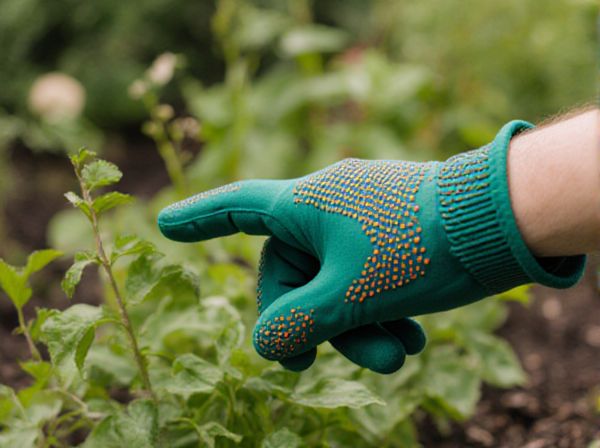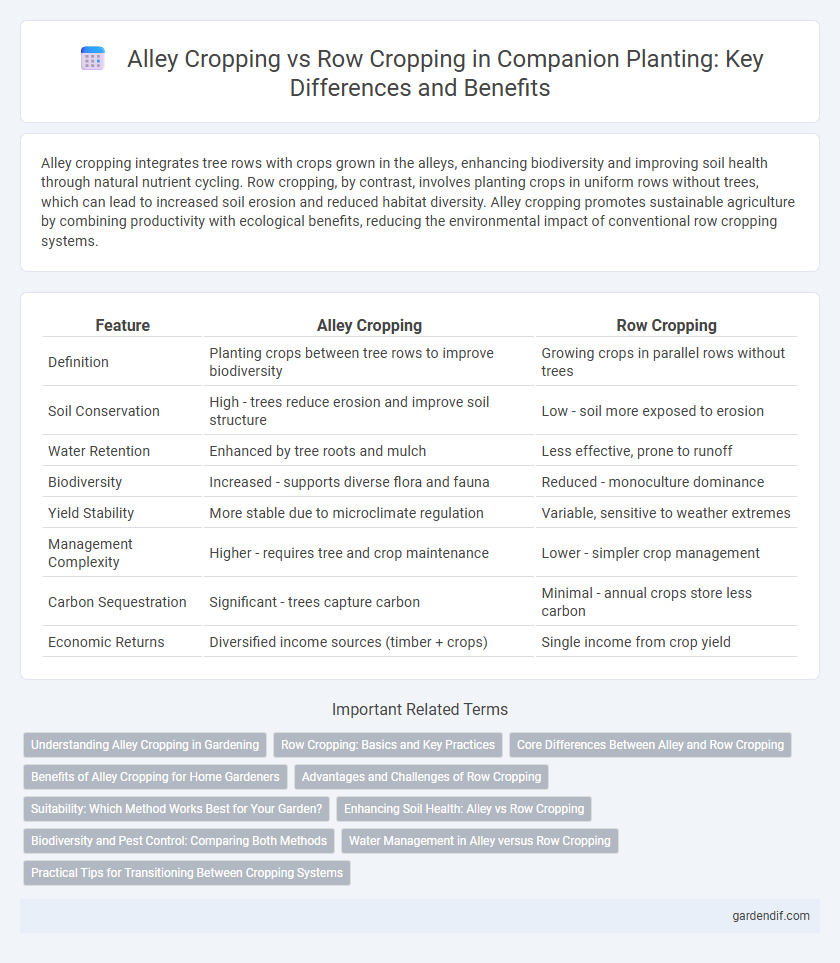
Alley cropping vs row cropping Illustration
Alley cropping integrates tree rows with crops grown in the alleys, enhancing biodiversity and improving soil health through natural nutrient cycling. Row cropping, by contrast, involves planting crops in uniform rows without trees, which can lead to increased soil erosion and reduced habitat diversity. Alley cropping promotes sustainable agriculture by combining productivity with ecological benefits, reducing the environmental impact of conventional row cropping systems.
Table of Comparison
| Feature | Alley Cropping | Row Cropping |
|---|---|---|
| Definition | Planting crops between tree rows to improve biodiversity | Growing crops in parallel rows without trees |
| Soil Conservation | High - trees reduce erosion and improve soil structure | Low - soil more exposed to erosion |
| Water Retention | Enhanced by tree roots and mulch | Less effective, prone to runoff |
| Biodiversity | Increased - supports diverse flora and fauna | Reduced - monoculture dominance |
| Yield Stability | More stable due to microclimate regulation | Variable, sensitive to weather extremes |
| Management Complexity | Higher - requires tree and crop maintenance | Lower - simpler crop management |
| Carbon Sequestration | Significant - trees capture carbon | Minimal - annual crops store less carbon |
| Economic Returns | Diversified income sources (timber + crops) | Single income from crop yield |
Understanding Alley Cropping in Gardening
Alley cropping in gardening involves planting rows of trees or shrubs with wide alleys of crops or vegetation cultivated in between, optimizing land use and promoting biodiversity. This method enhances soil fertility through nitrogen-fixing plants and reduces erosion by maintaining ground cover, contrasting with traditional row cropping that focuses solely on single crops spaced in uniform rows. Understanding alley cropping provides gardeners with sustainable practices that improve yield, encourage companion planting benefits, and create a resilient ecosystem.
Row Cropping: Basics and Key Practices
Row cropping involves planting crops in organized, evenly spaced rows to maximize sunlight exposure and airflow, enhancing growth and reducing disease risk. Key practices include precise seed placement, maintaining adequate row spacing for machinery access, and implementing crop rotation to improve soil fertility and prevent pest buildup. This method supports efficient irrigation, mechanical cultivation, and optimized nutrient management for higher yields.
Core Differences Between Alley and Row Cropping
Alley cropping integrates rows of trees or shrubs planted alongside crops, enhancing biodiversity and improving soil health, while row cropping involves cultivating crops in uniform rows without tree integration. This agroforestry system in alley cropping reduces erosion and promotes nutrient cycling, contrasting with row cropping's tendency toward soil degradation over time. Alley cropping supports sustainable land use by combining timber or fruit production with annual crops, unlike traditional row cropping focused solely on maximizing crop yield.
Benefits of Alley Cropping for Home Gardeners
Alley cropping enhances biodiversity and soil health by integrating trees or shrubs with crops, which improves microclimates and reduces erosion. This method maximizes land use efficiency, providing multiple yields such as fruits, nuts, or timber alongside vegetables in home gardens. Home gardeners benefit from the natural pest control and improved water retention that alley cropping promotes, leading to healthier and more resilient plants.
Advantages and Challenges of Row Cropping
Row cropping offers advantages such as easier mechanization, efficient irrigation, and better pest control due to defined plant spacing. Challenges include higher soil erosion risk and reduced biodiversity compared to alley cropping, which can impact long-term soil health. Adaptations like cover cropping and contour plowing can mitigate these challenges in row cropping systems.
Suitability: Which Method Works Best for Your Garden?
Alley cropping offers enhanced suitability for gardens with limited space by integrating tree rows with diverse understory crops, improving biodiversity and soil health. Row cropping suits gardens prioritizing monoculture with easier mechanization but may reduce ecosystem resilience. Selecting the best method depends on garden size, crop diversity goals, and management capacity.
Enhancing Soil Health: Alley vs Row Cropping
Alley cropping significantly enhances soil health by integrating tree rows with crops, which improves organic matter content, reduces erosion, and promotes nutrient cycling compared to traditional row cropping. The root systems in alley cropping stabilize soil structure and increase microbial activity, fostering better water retention and soil fertility. In contrast, row cropping often leads to soil degradation due to continuous tillage and lack of vegetative cover, making alley cropping a sustainable alternative for long-term soil health improvement.
Biodiversity and Pest Control: Comparing Both Methods
Alley cropping enhances biodiversity by integrating trees and shrubs with crops, creating habitats for beneficial insects and natural predators that help control pest populations. Row cropping, typically involving monocultures, offers fewer ecological niches, often leading to increased pest outbreaks and reliance on chemical pesticides. The diverse plant structure in alley cropping supports ecological balance and reduces pest damage more effectively than conventional row cropping.
Water Management in Alley versus Row Cropping
Alley cropping enhances water management by increasing soil infiltration and reducing surface runoff through the integration of trees and crops, which improves moisture retention compared to conventional row cropping. Trees in alley cropping systems create microclimates that reduce evapotranspiration and protect soils from erosion, leading to better water conservation. Row cropping typically experiences greater water loss and soil degradation due to exposed soil surfaces and limited root diversity.
Practical Tips for Transitioning Between Cropping Systems
Transitioning from row cropping to alley cropping requires careful planning to optimize space and soil health, incorporating fast-growing leguminous trees between rows of crops to improve nitrogen fixation and reduce erosion. Practical tips include selecting tree species compatible with crop types, adjusting planting density to balance light availability, and gradually introducing alley cropping to monitor effects on yield and soil structure. Regular assessment of water management practices and timely pruning of alley trees enhance crop growth and facilitate a smooth transition between systems.
Alley cropping vs row cropping Infographic

 gardendif.com
gardendif.com